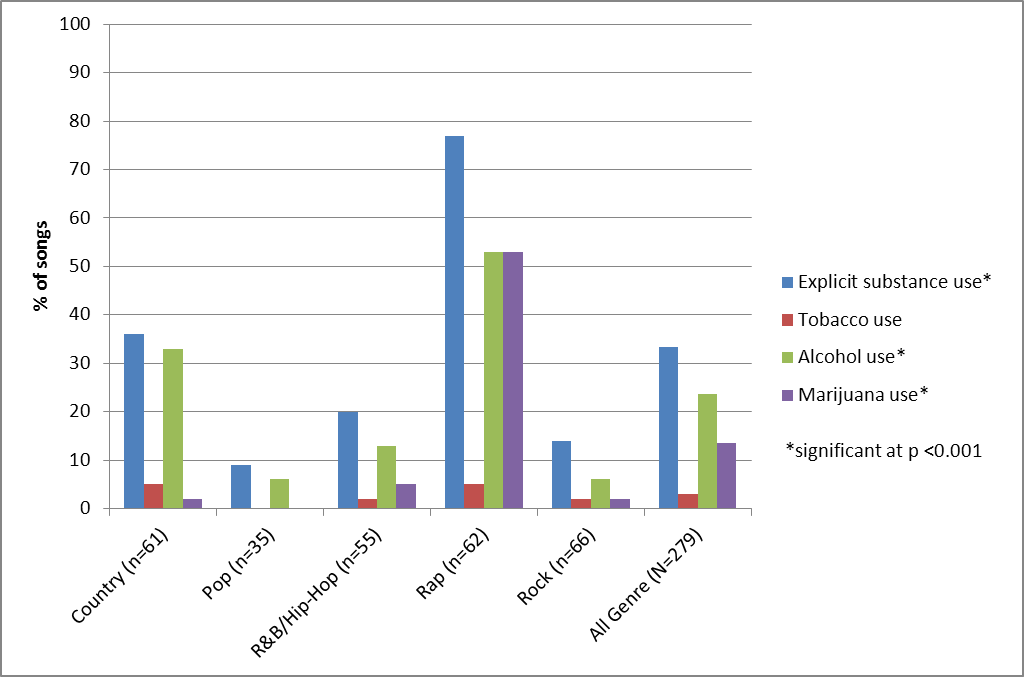In the last issue of Addiction & the Humanities, we looked at the presence of alcohol in movies, and its relationship to teen drinking (Humanities 8(4)). In contrast to the episodic nature of movie going, music listening can occur during any part of a teenager’s day – and this can add up to much larger exposure to substance use imagery. Today’s Addiction & the Humanities looks at a study that examined references to alcohol, tobacco, and other drugs in popular music (Primack, Dalton, Carroll et al., 2008).
Methods
Researchers collected data from Billboard magazine’s lists of popular song titles (based on airplay during 2005) and omitted charts that were not relevant to youth listening (Such as the “Adult Top 40”).
- Charts used: “Pop 100” (n=100), “Billboard Hot 100” (n=100), “Hot Country Tracks” (n=60), Hot R & B/Hip-Hop Songs” (n=100), “Hot Rap Tracks” (n=25), Mainstream Rock Tracks” (n=40), and “Modern Rock Tracks” (n=40).
- Due to overlap, the sample consisted of 279 unique songs
- Two independent coders analyzed the songs for genre, inclusion characteristics, and types of inclusion. This review will address findings related to genre and referencing various substances.
- Researchers coded genre based on their appearance on the various sub charts (e.g., any songs appearing on the Pop/Hot 100 charts but not on any sub chart were categorized as pop).
- Researchers coded references based on implicit and/or explicit inclusion of various substances (i.e., tobacco, alcohol, marijuana, and other substances)
- The authors used x2 tests to determine statistical significance between genres for the frequency of different substance use references.
Results
- Of the 279 unique songs, 93 contained explicit substance use references (33.3%) (see Figure)
- The most frequently referenced substance was alcohol (23.7%) followed by marijuana (13.6%) and other illicit drugs (11.5%). Songs mentioned tobacco use relatively few times (i.e., 2.9% of songs).
- References for all types of substances, except tobacco, varied by genre (statistics not reported).
- Examination of the number of references suggested that rap music contained the most references to explicit substance use, alcohol use, marijuana use, and other illicit drugs (not shown).
Figure: Percentage of songs referencing substance use. Adapted from Primack et. al. (2008).
Limitations
- Small sample size (n=279) and limited dataset timeframe (2005 only)
- The author of this paper has a follow-up alcohol specific study involving a larger sample (n=793, years 2005-2007) with a similar rate of explicit alcohol references (21.3%) (Primack, Nuzzo, Rice et al., 2012)
- Billboard charts of music represent the entire listening audience and therefore, might not be representative of adolescent listening habits.
Discussion
This study finds that about a third of the most popular music in the U.S. includes references to substance use. When dividing the songs up by genre, explicit substance use appears most frequently in rap music and least frequently in pop music. Because adolescents have differing tastes in music, this suggests that an individual might experience more or fewer references to substance based not only on how much music they listen to, but also by their taste in music.
Rather than focusing solely on negative physical and legal consequences of substance use, health education could consider debunking the positive outcomes referred to in music (i.e. sexual and financial motivations). Additionally, programs could focus on teaching students how to complete critical analyses of various media to which they frequently are exposed.
Although the study gives a comprehensive overview of substance use references in popular music, it does not explore the effects of this exposure on adolescents. Future work should focus on the relationship between adolescent music exposure and substance abuse.
~Jed Jeng
What do you think? Please use the comment link below to provide feedback on this article.
References
Primack, B. A., Dalton, M. A., Carroll, M. V., Agarwal, A. A., & Fine, M., J. (2008). Content Analysis of Tobacco, Alcohol, and Other Drugs in Popular Music. Archives of Pediatric & Adolescent Medicine, 162(2), 169-175.
Primack, B. A., Nuzzo, E., Rice, K. R., & Sargent, J. D. (2012). Alcohol brand appearances in US popular music. Addiction, 107(3), 557-566.






lisa June 19, 2017
Drug use in popular music scene is becoming a menace. something should be done